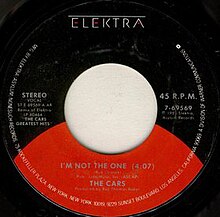I'm Not the One
| "I'm Not the One" | ||||
|---|---|---|---|---|
 |
||||
| Single by The Cars | ||||
| from the album Shake It Up | ||||
| B-side | "Heartbeat City" (US) "Since You're Gone" (UK) |
|||
| Released | January 13, 1986 | |||
| Recorded | 1981 | |||
| Length | 4:12 | |||
| Label | Elektra 69569 | |||
| Songwriter(s) | Ric Ocasek | |||
| Producer(s) | Roy Thomas Baker | |||
| The Cars singles chronology | ||||
|
||||
| Shake It Up track listing | ||||
|
9 tracks
|
||||
"I'm Not the One" is a song by the American rock band The Cars, from their fourth album, Shake It Up. It features Ric Ocasek on lead vocals, Benjamin Orr singing the 'You Know Why' phrase, with the whole group repeating "going round and round" as backing vocals throughout the song.
"I'm Not the One" first appeared in 1981 on Shake It Up. It was not a charting single at the time, but was nonetheless included on the band's 1985 Greatest Hits album. The song was remixed on the Greatest Hits album, emphasizing the drum track with added reverb. It was then released as a single in 1986, following "Tonight She Comes", also from the Greatest Hits album. "I'm Not the One" debuted on the Billboard Top 40 chart on March 8, 1986, and peaked at number 32.
AllMusic reviewer Donald A. Guarisco described "I'm Not the One" as one of Shake It Up's "strongest and most memorable tunes", commenting that its sound still sounded fresh upon its 1986 re-release, five years after its first appearance on Shake It Up.
In 2005, the album, Substitution Mass Confusion: A Tribute to The Cars, was released on Not Lame Recordings, which included a cover of "I'm Not the One" by Gigolo Aunts.
The song's intro and choruses are in the key of B minor. The intro features two synthesizer parts layered on top of each other, one derived from Ric Ocasek's vocal melody, and the other a supporting counter-melody in a softer tone. The intro/chorus begins with a chord progression of B minor, F♯ minor, E minor, and A major, but is immediately followed with a reversal, F♯ minor to B minor, retaining the E minor to A major movement. After another "reversed" repeat, the E minor to A functions as a ii-V-I turnaround in the key's relative major of D.
...
Wikipedia
